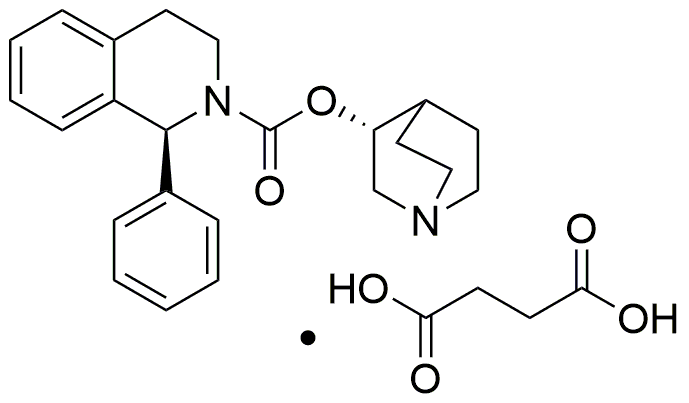Solifenacin succinate is widely utilized in research focused on:
- Overactive Bladder Treatment: This compound is primarily used in the pharmaceutical industry to manage symptoms of overactive bladder, providing relief from frequent urination and urgency.
- Pharmacological Studies: Researchers study its efficacy and safety profile, helping to develop better therapeutic strategies and improve patient outcomes.
- Combination Therapies: Solifenacin succinate is often explored in combination with other medications to enhance treatment effectiveness for urinary disorders.
- Patient Compliance Research: Its once-daily dosing schedule makes it a focus in studies aimed at improving adherence to treatment regimens among patients.
- Drug Development: The compound serves as a model in drug formulation research, allowing scientists to investigate new delivery methods and formulations for improved bioavailability.
Informations générales
Propriétés
Sécurité et réglementation
Applications
Solifenacin succinate is widely utilized in research focused on:
- Overactive Bladder Treatment: This compound is primarily used in the pharmaceutical industry to manage symptoms of overactive bladder, providing relief from frequent urination and urgency.
- Pharmacological Studies: Researchers study its efficacy and safety profile, helping to develop better therapeutic strategies and improve patient outcomes.
- Combination Therapies: Solifenacin succinate is often explored in combination with other medications to enhance treatment effectiveness for urinary disorders.
- Patient Compliance Research: Its once-daily dosing schedule makes it a focus in studies aimed at improving adherence to treatment regimens among patients.
- Drug Development: The compound serves as a model in drug formulation research, allowing scientists to investigate new delivery methods and formulations for improved bioavailability.
Documents
Fiches de données de sécurité (FDS)
La FDS fournit des informations de sécurité complètes sur la manipulation, le stockage et l’élimination du produit.
Spécifications du produit (PS)
Le PS fournit une description complète des propriétés du produit, notamment sa composition chimique, son état physique, sa pureté et les exigences de stockage. Il détaille également les plages de qualité acceptables et les applications prévues du produit.
Certificats d'analyse (COA)
Recherchez des certificats d'analyse (COA) en saisissant le numéro de lot du produit. Les numéros de lot et de lot se trouvent sur l'étiquette d'un produit, après les mots « Lot » ou « Lot de fabrication ».
Numéro de catalogue
Numéro de lot/série
Certificats d'origine (COO)
Ce certificat d'exploitation confirme le pays dans lequel le produit a été fabriqué, et détaille également les matériaux et composants utilisés et s'il est issu de sources naturelles, synthétiques ou autres sources spécifiques. Ce certificat peut être requis pour les douanes, le commerce et la conformité réglementaire.
Numéro de catalogue
Numéro de lot/série
Fiches de données de sécurité (FDS)
La FDS fournit des informations de sécurité complètes sur la manipulation, le stockage et l’élimination du produit.
DownloadSpécifications du produit (PS)
Le PS fournit une description complète des propriétés du produit, notamment sa composition chimique, son état physique, sa pureté et les exigences de stockage. Il détaille également les plages de qualité acceptables et les applications prévues du produit.
DownloadCertificats d'analyse (COA)
Recherchez des certificats d'analyse (COA) en saisissant le numéro de lot du produit. Les numéros de lot et de lot se trouvent sur l'étiquette d'un produit, après les mots « Lot » ou « Lot de fabrication ».
Numéro de catalogue
Numéro de lot/série
Certificats d'origine (COO)
Ce certificat d'exploitation confirme le pays dans lequel le produit a été fabriqué, et détaille également les matériaux et composants utilisés et s'il est issu de sources naturelles, synthétiques ou autres sources spécifiques. Ce certificat peut être requis pour les douanes, le commerce et la conformité réglementaire.


